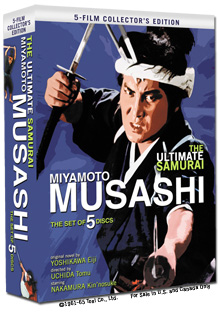 It is my great pleasure to announce, if you didn't know already, that AnimEigo is releasing Tomu Uchida's five-part "Zen and Sword" version of Miyamoto Musashi (1961-65). For fans of Japan's Greatest Swordsman, this is definitely a cause for celebration. Uchida's sprawling epic film series adheres faithfully to Eiji Yoshikawa's sprawling epic novel (well, as faithfully as possible given that the latter weighs in at 970 pages). At times the films follow the book page by page, even line by line. This makes for a far different film experience than Hiroshi Inagaki's more well-known three-part saga starring Toshiro Mifune (1954-56). Indeed, apart from the first installment and a few other key events, the two film series are remarkably dissimilar. While the Inagaki films take more liberties with the source material, the most striking difference lies in the performance of the two stars. Don't get me wrong, nobody loves Toshiro Mifune more than me, but when it comes to emotional range and screen intensity, I gotta hand it to Kinnosuke Nakamura. His steadily mesmerizing performance is the strongest selling point of the Zen and Sword Miyamoto Musashi.
It is my great pleasure to announce, if you didn't know already, that AnimEigo is releasing Tomu Uchida's five-part "Zen and Sword" version of Miyamoto Musashi (1961-65). For fans of Japan's Greatest Swordsman, this is definitely a cause for celebration. Uchida's sprawling epic film series adheres faithfully to Eiji Yoshikawa's sprawling epic novel (well, as faithfully as possible given that the latter weighs in at 970 pages). At times the films follow the book page by page, even line by line. This makes for a far different film experience than Hiroshi Inagaki's more well-known three-part saga starring Toshiro Mifune (1954-56). Indeed, apart from the first installment and a few other key events, the two film series are remarkably dissimilar. While the Inagaki films take more liberties with the source material, the most striking difference lies in the performance of the two stars. Don't get me wrong, nobody loves Toshiro Mifune more than me, but when it comes to emotional range and screen intensity, I gotta hand it to Kinnosuke Nakamura. His steadily mesmerizing performance is the strongest selling point of the Zen and Sword Miyamoto Musashi.If you bought my latest book, Warring Clans, Flashing Blades (and if you didn't, that link goes right to Amazon wink wink), you'll know something about Kinnosuke Nakamura (I included a biographical sketch of this most beloved of jidai-geki stars right at the front and reviewed half a dozen of his films). At one point I said, "Toshiro Mifune had a natural talent, keen instincts, and quick reactions; Tatsuya Nakadai is the master thespian, cool and chameleonic; Shintaro Katsu was bold and genuine; Raizo Ichikawa had versatility and a perfectly poised heroic persona; but when it came to communicating sheer emotion, often in complex combinations, nobody did it like Nakamura." You need go no further than the Zen and Sword series for ample proof.
 As I mentioned earlier, the first film in the quintilogy (it's a word now) covers the same ground as the Inagaki version, beginning with the Battle of Sekigahara and following the teenage Musashi (then called Takezo) and his loser buddy Matahachi (Asao Kimura) as they make their way from the corpse-strewn battlefield towards an uncertain future in the new Tokugawa era. Matahachi's bitch-on-wheels mama-san (Chieko Naniwa) gets it into her fool head that Takezo is somehow responsible for her son's death (even though he isn't dead) and her quest for revenge is a running gag throughout the series. Meanwhile, Matahachi's fiance Otsu (Wakaba Irie) winds up falling for Takezo while Matahachi runs off with older-and-bolder Oko (Michiyo Kogure). Takuan the Know-It-All Priest (Rentaro Mikuni) eventually takes the wild Takezo to Himeji Castle where the young mountain madman studies to become a great samurai. One down, four to go.
As I mentioned earlier, the first film in the quintilogy (it's a word now) covers the same ground as the Inagaki version, beginning with the Battle of Sekigahara and following the teenage Musashi (then called Takezo) and his loser buddy Matahachi (Asao Kimura) as they make their way from the corpse-strewn battlefield towards an uncertain future in the new Tokugawa era. Matahachi's bitch-on-wheels mama-san (Chieko Naniwa) gets it into her fool head that Takezo is somehow responsible for her son's death (even though he isn't dead) and her quest for revenge is a running gag throughout the series. Meanwhile, Matahachi's fiance Otsu (Wakaba Irie) winds up falling for Takezo while Matahachi runs off with older-and-bolder Oko (Michiyo Kogure). Takuan the Know-It-All Priest (Rentaro Mikuni) eventually takes the wild Takezo to Himeji Castle where the young mountain madman studies to become a great samurai. One down, four to go.Over the course of the remaining films, we find Musashi (a different reading of the kanji for Takezo given him by the Lord of Himeji) confronting scores of opponents, his battles ranging from single combat with sword masters to full-on melee with scores of attackers. It's all too sprawling and epic-y to describe in detail here. The labyrinthine, Dickensian plot has all the many main characters becoming interconnected with one another (if they weren't already) and by the final battle between Musashi and arch rival Kojiro Sasaki (a bewigged Ken Takakura), you feel as if you've been on your own journey of thrilling adventure and discovery.
If you're new to samurai cinema, this Musashi series is a great place to start. If you're already into the genre, trust me, you've got to have it. Just plain excellent.


2 comments:
Pat- cool review. And your bio of Nakamura in WCFB rocks!
Domo arigato, Obenjo-sama.
Post a Comment